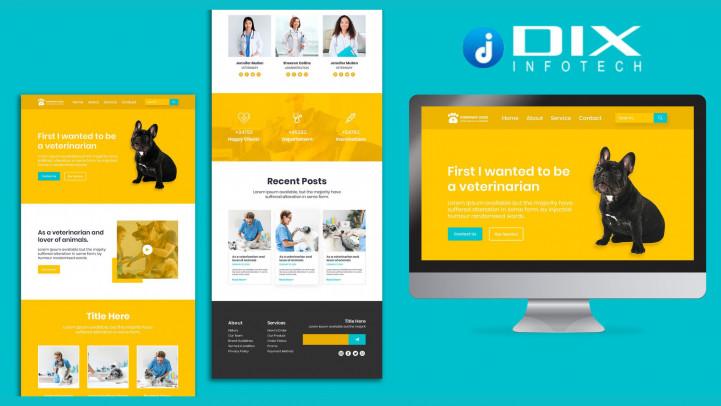Definition of a landing Page
A landing page is a dedicated web page that serves as a crucial element of your online marketing strategy. It is specifically designed to capture the attention and interest of visitors who arrive through various channels such as online ads, search engine results, social media links, or email campaigns. Unlike other pages on your website, a landing page has a singular focus – to encourage visitors to take a specific action, such as making a purchase, filling out a form, subscribing to a newsletter, or downloading an ebook.
Importance of landing page optimization for higher conversion rates
Landing page optimization plays a pivotal role in achieving higher conversion rates and maximizing the success of your marketing campaigns. A well-optimized landing page can significantly enhance the likelihood of visitors taking the desired action, thereby increasing the return on investment (ROI) for your marketing efforts. Here are a few key reasons why landing page optimization is of utmost importance:
- Enhanced Relevance: A properly optimized landing page ensures that the content and message align closely with the visitor's expectations. By delivering a relevant and personalized experience, you can capture their attention and build trust, increasing the chances of conversion.
- Improved User Experience: Optimization techniques like streamlined navigation, intuitive design, and fast page load speed contribute to an exceptional user experience. A seamless and user-friendly interface eliminates friction and encourages visitors to engage further, leading to higher conversion rates.
- Higher Conversion Rates: By implementing proven optimization strategies, such as persuasive copywriting, compelling visuals, effective calls-to-action (CTAs), and trust signals, you can create a persuasive environment that compels visitors to take action. This, in turn, increases the likelihood of conversion and accomplishing your marketing goals.
- Data-Driven Insights: Landing page optimization involves continuous testing, analysis, and refinement based on user data. By leveraging tools and techniques like A/B testing, heatmaps, and analytics, you gain valuable insights into visitor behavior, preferences, and pain points. These insights empower you to make data-driven decisions, resulting in improved conversion rates over time.
- Cost-Effectiveness: Optimizing your landing pages allows you to make the most of your marketing budget. By fine-tuning the elements that impact conversion rates, you can extract higher value from your advertising spend and generate more leads or sales without necessarily increasing your marketing budget.
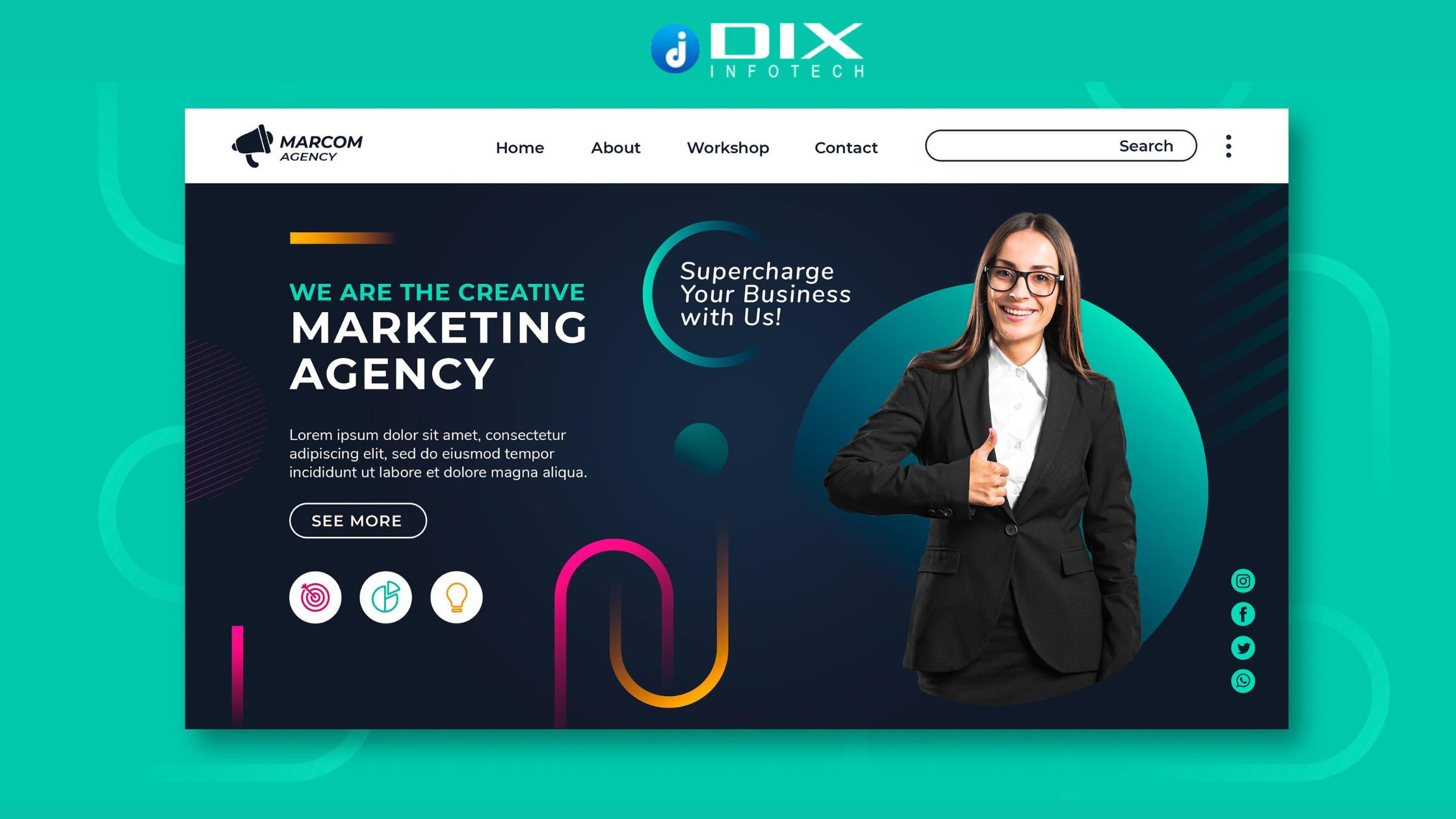
Must Read : 30 Proven ways to Increase traffic to your website
Landing Page Design
A. Key elements of an effective landing page design
To create an effective landing page that captures the attention of your visitors and encourages them to take action, you need to consider the following key elements:
- Clear and compelling headline:
A strong headline is crucial as it is the first thing visitors see when they land on your page. It should clearly communicate the value proposition or the main benefit you offer. Make it concise, attention-grabbing, and aligned with the visitor's expectations.
- Engaging and relevant content:
The content on your landing page should be concise, persuasive, and focused on addressing the visitor's pain points or needs. Clearly articulate the benefits of your product, service, or offer, and highlight what sets you apart from the competition.
- Attention-grabbing visuals:
Visual elements such as images, videos, or graphics can significantly enhance the visual appeal and engagement of your landing page. Use high-quality visuals that are relevant to your offering and help convey your message more effectively.
- Intuitive navigation and layout:
The layout and navigation of your landing page should be user-friendly and intuitive. Ensure that visitors can easily navigate through the page and find the information they need. Use logical section divisions, clear headings, and appropriate spacing to enhance readability and flow.
B. Landing page templates and their advantages
Landing page templates provide pre-designed layouts and structures that can expedite the process of creating a landing page. They offer several advantages, including:
- Time-saving: Templates eliminate the need to start from scratch, saving you time and effort in designing and structuring your landing page. You can simply customize the template to match your branding and goals.
- Design consistency: Templates provide a consistent design framework, ensuring that your landing pages maintain a cohesive and professional look across different campaigns or variations.
- Proven effectiveness: Many landing page templates are built based on industry best practices and conversion optimization principles. They are often optimized for specific purposes such as lead generation or product sales, increasing the chances of success.
- Responsive and mobile-friendly: Templates are typically designed to be responsive and mobile-friendly, ensuring that your landing page looks and functions well on various devices, including smartphones and tablets.
While templates can be a valuable starting point, it's essential to customize them to suit your specific needs, branding, and target audience. This customization should include incorporating your unique content, visuals, and calls-to-action to ensure that your landing page stands out and effectively communicates your message.
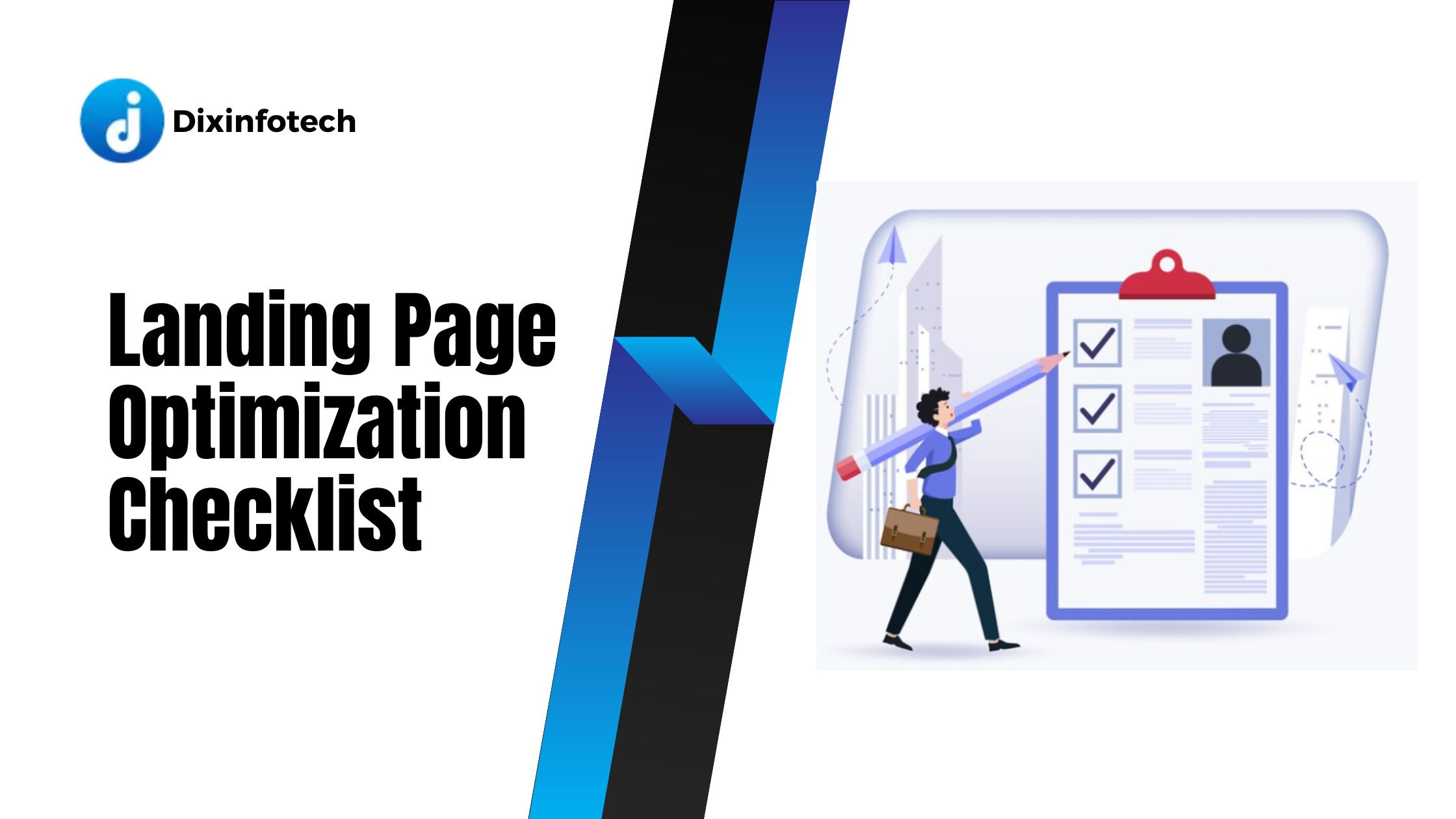
Must Read : Why Is SEO Important For Small Businesses
Landing Page Optimization Checklist
A. Optimizing landing page load speed
Minimize file sizes: Compress and optimize images, scripts, and other elements to reduce the page's file size and improve loading speed.
Enable browser caching: Utilize browser caching to store static resources, such as images and CSS files, so that returning visitors can load the page faster.
Reduce redirects: Minimize the number of redirects on your landing page, as each redirect adds extra time to the page load process.
Optimize hosting and server performance: Choose a reliable hosting provider and ensure your server is capable of handling the anticipated traffic to avoid slowdowns.
B. Ensuring mobile responsiveness
- Use responsive design: Design your landing page to be responsive, meaning it adapts and displays properly across different screen sizes and devices.
- Test on various devices: Verify that your landing page appears and functions correctly on different smartphones, tablets, and browsers.
- Simplify navigation: Optimize the navigation for mobile users by using mobile-friendly menus, buttons, and intuitive gestures.
C. Crafting persuasive and concise copy
Communicate value proposition: Clearly articulate the unique value your product or service offers to visitors, highlighting how it addresses their needs or pain points.
- Use compelling headlines: Create attention-grabbing headlines that immediately captivate visitors and encourage them to continue reading.
- Keep it concise: Use clear and concise language to convey your message, avoiding unnecessary jargon or complex terminology.
- Highlight benefits: Emphasize the benefits visitors will gain by taking the desired action, focusing on how it will improve their lives or solve their problems.
D. Utilizing compelling call-to-action (CTA) buttons
- Clear and prominent placement: Position your CTA buttons prominently on the page where they are easily noticeable and accessible.
- Use contrasting colors: Make your CTA buttons stand out by using colors that contrast with the overall color scheme of the page.
- Use persuasive copy: Craft concise and action-oriented text on the buttons that clearly communicates the desired action visitors should take.
- Create a sense of urgency: Incorporate urgency in your CTAs by using phrases like "Limited time offer" or "Act now" to encourage immediate action.
E. Implementing trust signals and social proof
- Include testimonials and reviews: Display positive testimonials and reviews from satisfied customers to build trust and credibility.
- Showcase trust badges: Display recognizable trust badges or security seals that assure visitors that their information is safe.
- Highlight customer success stories: Share case studies or success stories to demonstrate how your product or service has benefited previous customers.
F. Conducting A/B testing for continuous improvement
- Test different elements: Perform A/B tests on various elements of your landing page, such as headlines, CTAs, colors, layouts, or form fields, to identify what resonates best with your audience.
- Set clear goals: Define specific conversion goals and metrics to track during A/B testing, such as click-through rates, form submissions, or purchases.
- Analyze and iterate: Analyze the results of your A/B tests and make data-driven decisions to optimize your landing page further. Implement the winning variations and continue testing to continually improve conversion rates.
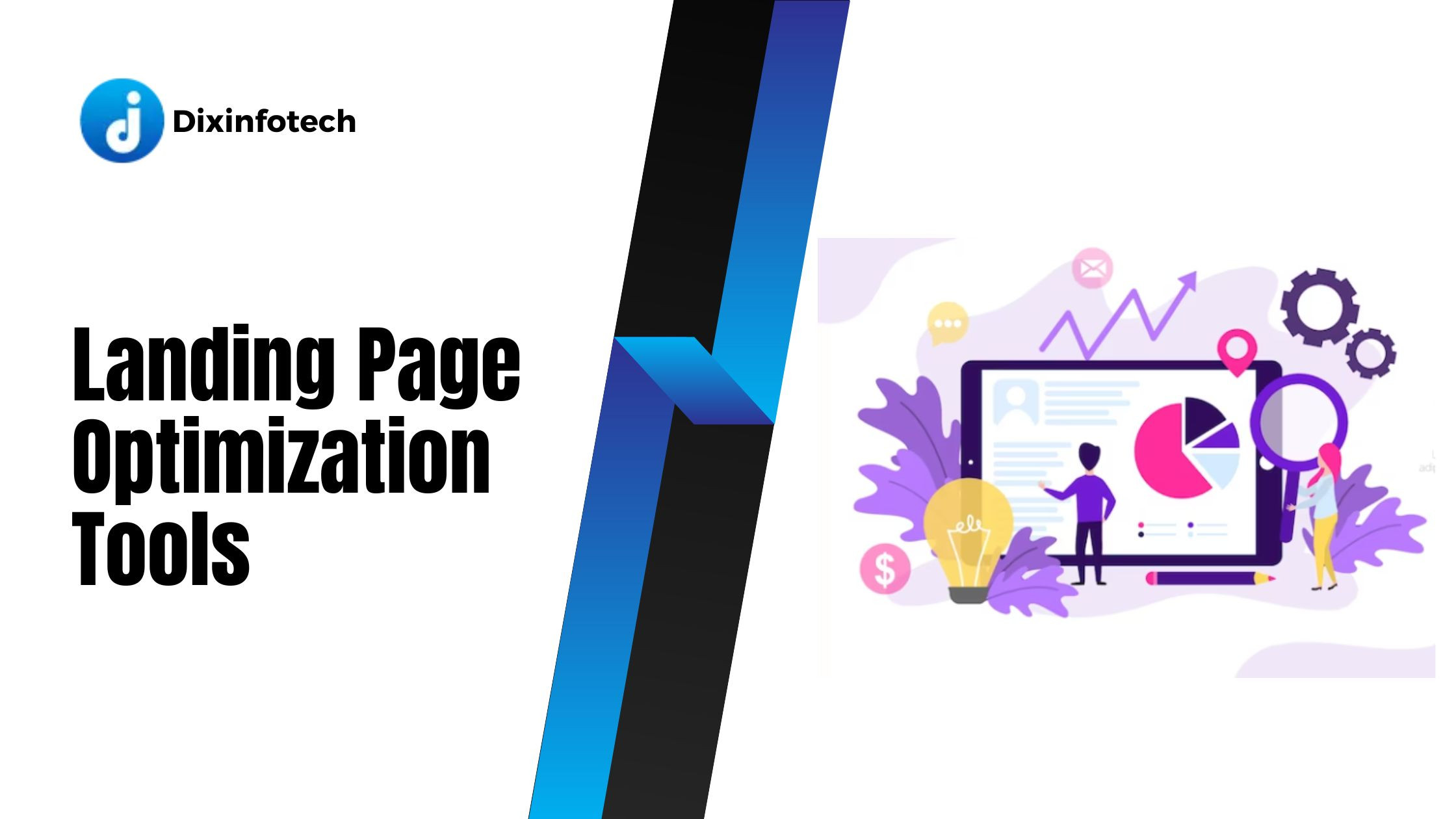
Must Read : Making SEO a Vitamin for your Business
Landing Page Optimization Tools
A. Overview of popular landing page optimization tools
There are various landing page optimization tools available in the market, each offering unique features to help improve the effectiveness of your landing pages. Here's an overview of some popular tools:
Unbounce:
Unbounce is a versatile landing page builder that allows you to create, test, and optimize landing pages without coding knowledge. It offers a drag-and-drop interface, A/B testing capabilities, dynamic text replacement, and integration with popular marketing tools.
Instapage:
Instapage is a user-friendly landing page platform that provides a range of customizable templates, a drag-and-drop editor, A/B testing, heatmaps, and analytics. It also offers integrations with popular marketing automation and CRM platforms.
Optimizely:
Optimizely is a comprehensive experimentation platform that enables A/B testing, multivariate testing, and personalization. It provides a visual editor, real-time analytics, and advanced targeting options for creating personalized landing page experiences.
Google Optimize:
Google Optimize is a free A/B testing and personalization tool that integrates with Google Analytics. It offers an intuitive visual editor, audience targeting, and advanced statistical modeling to optimize your landing pages.
B. Features and benefits of each tool
Unbounce:
- Drag-and-drop editor: Easily create and customize landing pages without coding.
- A/B testing: Test different variations of your landing page to determine the most effective design and content.
- Dynamic text replacement: Personalize landing page content based on the keywords or ad copy that led visitors to the page.
- Integration capabilities: Seamlessly connect with popular marketing tools to streamline your workflow.
Instapage:
- Customizable templates: Choose from a wide range of professionally designed templates and customize them to match your brand.
- A/B testing: Test different page elements to identify high-converting variations.
- Heatmaps: Gain insights into user behavior and engagement with visual heatmaps.
- Integrations: Connect with various marketing automation and CRM platforms to streamline lead management.
Optimizely:
- Advanced experimentation: Conduct A/B tests, multivariate tests, and personalization campaigns to optimize your landing pages.
- Visual editor: Modify landing page elements visually without coding.
- Real-time analytics: Monitor test results and gather insights on visitor behavior in real-time.
- Advanced targeting: Target specific audience segments for personalized landing page experiences.
Google Optimize:
- Free and user-friendly: Access basic A/B testing and personalization features at no cost with a simple setup process.
- Integration with Google Analytics: Leverage the power of Google Analytics data to inform your optimization decisions.
- Visual editor: Make changes to your landing pages using a user-friendly visual editor.
- Advanced targeting and segmentation: Define specific audience segments for personalized experiences based on visitor attributes or behaviors.
C. How to select the right tool for your needs
When selecting a landing page optimization tool, consider the following factors:
- Budget: Determine your budget for landing page optimization tools, as some tools may have associated costs based on features or usage limits.
- Required features: Identify the specific features you need, such as A/B testing, heatmaps, visual editors, or integrations with your existing marketing tools.
- Ease of use: Consider the tool's user interface and whether it aligns with your team's technical expertise and workflow.
- Scalability: If you anticipate growing your landing page optimization efforts, choose a tool that can accommodate your future needs and allows for scalability.
- Integration capabilities: If you rely on specific marketing tools or platforms, ensure that the landing page optimization tool integrates smoothly with them.
- Support and resources: Evaluate the level of customer support provided by the tool's vendor and the availability of documentation, tutorials, and resources for assistance.
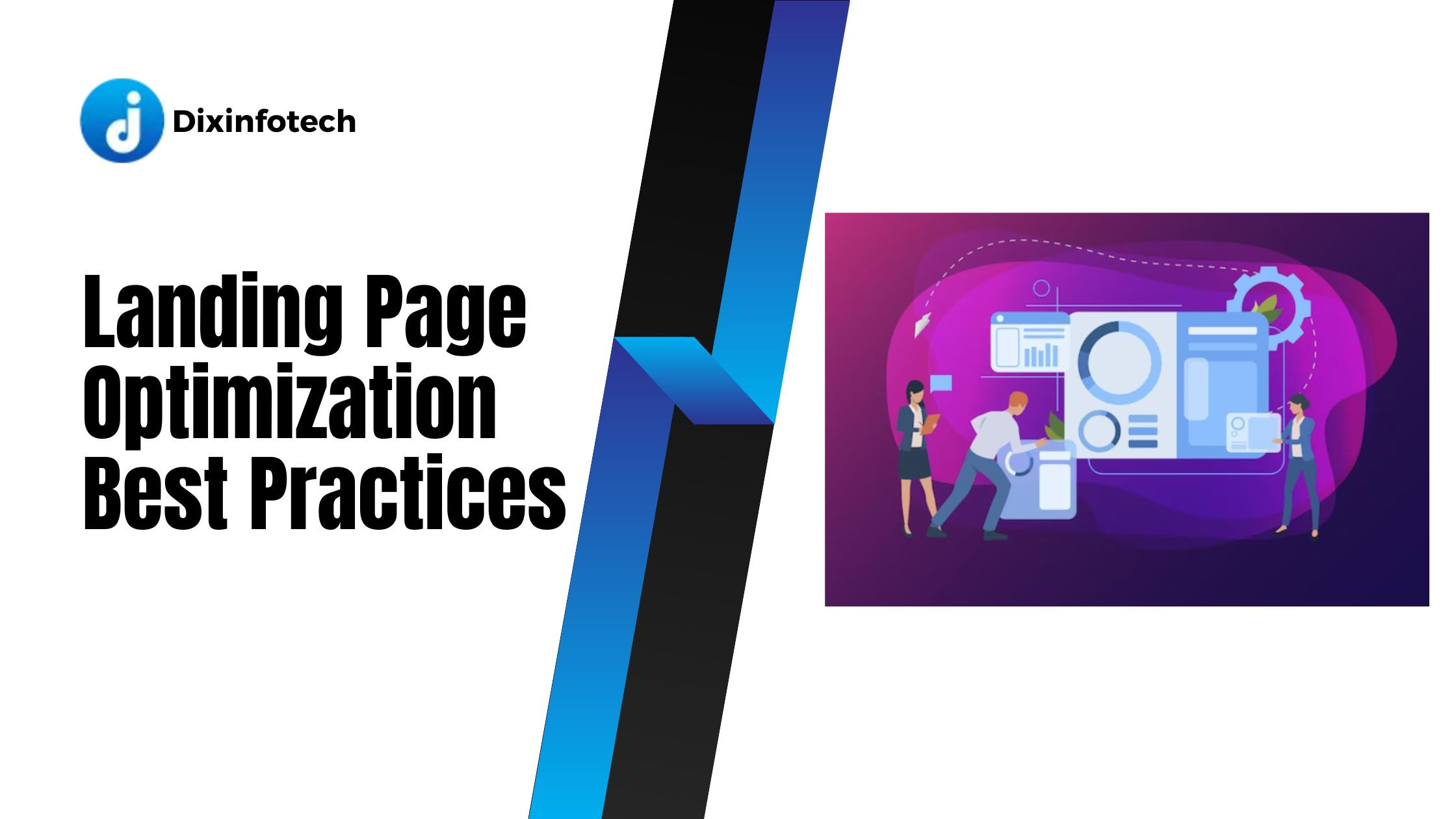
Must Read : The Basics of On Page SEO for Better Rankings
Landing Page Optimization Best Practices
A. Crafting a strong value proposition
- Clearly communicate the unique value and benefits your offering provides to visitors.
- Use compelling headlines and subheadings to highlight your value proposition.
- Focus on addressing the specific pain points or needs of your target audience.
- Use concise and persuasive language to convey your value proposition effectively.
B. Using persuasive visuals and multimedia
- Incorporate high-quality images, videos, or graphics that are relevant to your offering.
- Use visuals to showcase product features, demonstrate use cases, or evoke emotions.
- Optimize multimedia elements for fast loading speed and compatibility across devices.
- Ensure visuals align with your brand identity and support your value proposition.
C. Optimizing forms for lead generation
- Keep forms simple and concise, asking only for essential information.
- Minimize the number of form fields to reduce friction and encourage completion.
- Use clear and descriptive labels for form fields.
- Incorporate inline validation to provide real-time feedback and reduce errors.
- Consider using progressive profiling to gather additional information over time.
D. Personalizing landing pages based on user data
- Utilize data collected from previous interactions or user preferences to personalize landing page content.
- Customize headlines, visuals, and offers based on visitor demographics or behavior.
- Implement dynamic content that changes based on user attributes or segmentation.
- Leverage personalized recommendations or product suggestions to enhance engagement.
E. Implementing effective CTA placement and design
- Ensure CTAs are prominently placed and visually stand out on the page.
- Use contrasting colors and clear, action-oriented language on CTA buttons.
- Consider using directional cues, such as arrows or visual cues, to draw attention to the CTA.
Test different CTA placements and designs to optimize for higher click-through rates.
F. Incorporating relevant testimonials and case studies
- Display testimonials from satisfied customers to build trust and credibility.
- Include case studies that showcase real-world examples of how your offering has benefited customers.
- Highlight specific results or outcomes achieved by previous customers.
- Use testimonials and case studies that are relevant to your target audience or specific use cases.
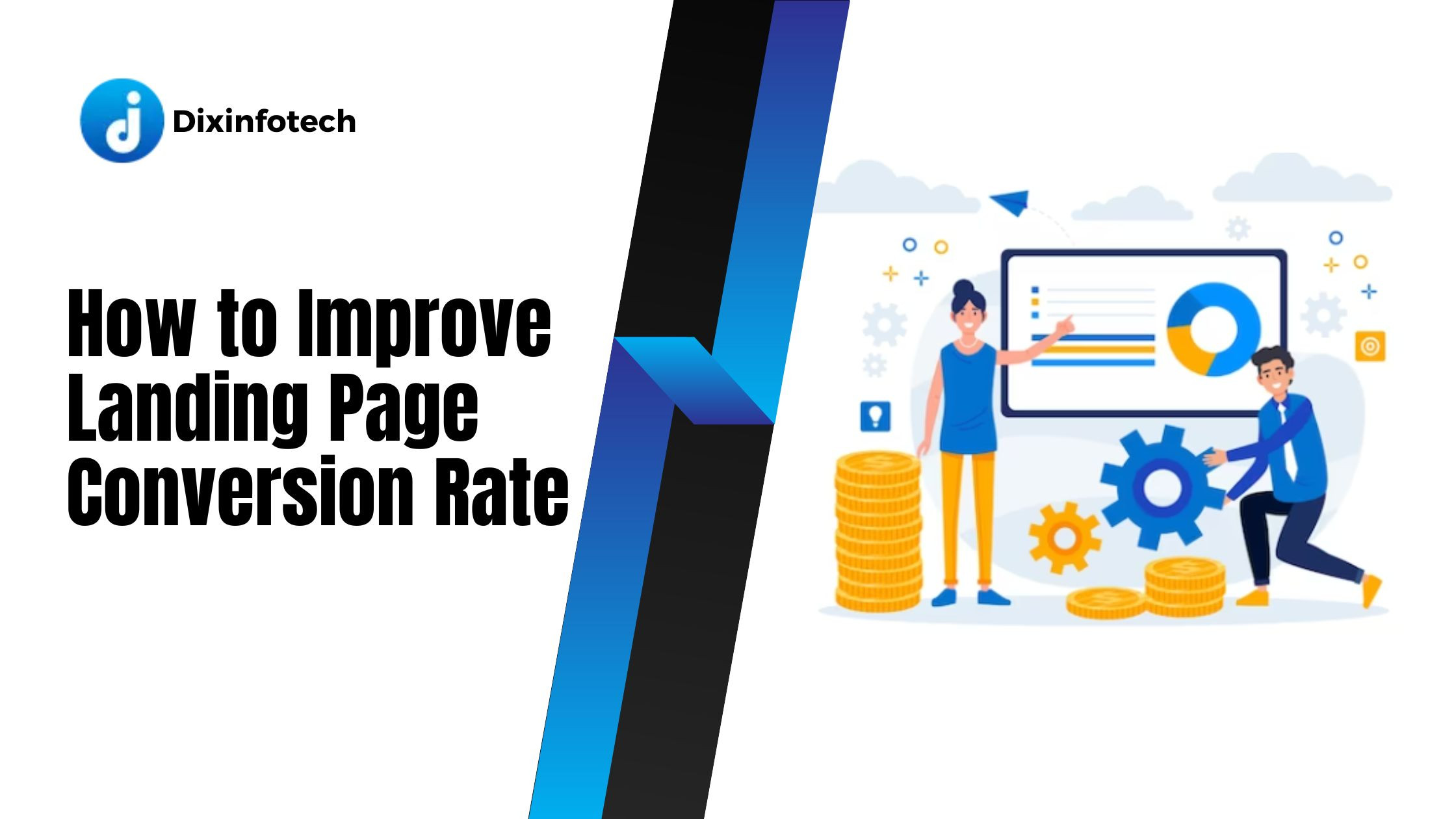
How to Improve Landing Page Conversion Rate
A. Conducting audience research and segmentation
- Understand your target audience's needs, preferences, and pain points.
- Conduct market research and collect data to segment your audience into relevant groups.
- Tailor your landing page content and messaging to resonate with each audience segment.
- Personalize the user experience based on demographic or behavioral data.
B. Analyzing landing page metrics and user behavior
- Use analytics tools to track and analyze landing page performance metrics.
- Monitor key metrics such as bounce rate, conversion rate, time on page, and click-through rate.
- Identify patterns and trends in user behavior through heatmaps, scroll maps, and user recordings.
- Use data insights to identify areas for improvement and optimization.
C. Identifying and addressing potential barriers to conversion
- Review user feedback, surveys, and customer support interactions to identify common concerns or obstacles.
- Identify and address potential friction points on the landing page, such as complicated forms or unclear instructions.
- Optimize page loading speed to prevent user frustration and high bounce rates.
- Ensure mobile responsiveness and compatibility to cater to users on different devices.
D. Implementing effective A/B testing strategies
- Develop hypotheses and create different variations of your landing page elements.
- Split your traffic and randomly assign users to different variations for testing.
- Measure and compare the performance of each variation based on predefined metrics.
- Implement the winning variations and continue testing new hypotheses to further optimize conversion rates.
E. Leveraging persuasive copywriting techniques
- Create compelling headlines and subheadings that capture attention and communicate value.
- Use persuasive language to highlight the benefits and unique selling points of your offering.
- Incorporate storytelling techniques to engage and emotionally connect with your audience.
- Use clear and concise copy that guides users through the desired conversion process.
- Apply persuasive writing techniques, such as social proof, scarcity, and urgency, to encourage action.
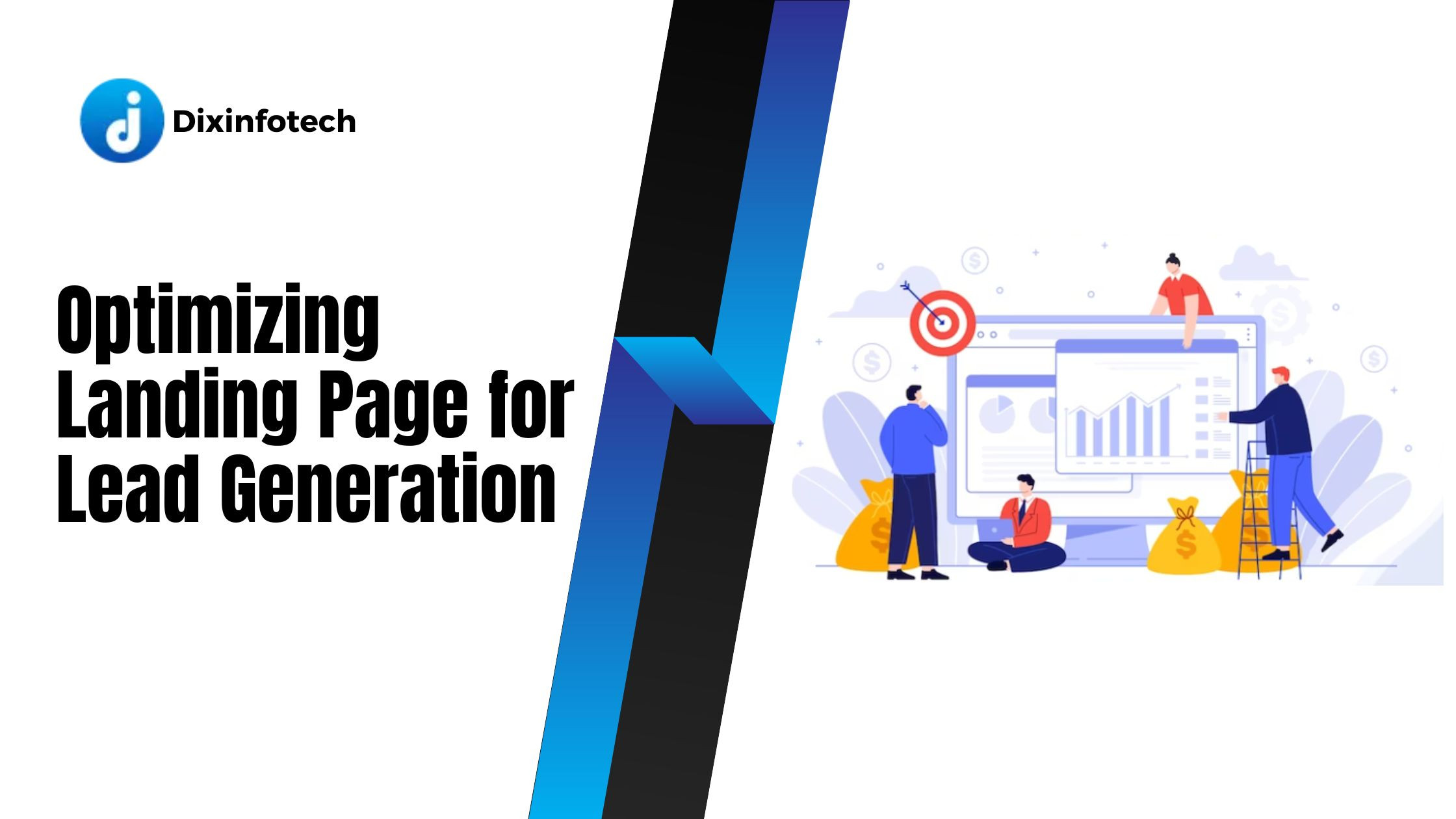
Optimizing Landing Page for Lead Generation
A. Designing forms for optimal conversion
- Keep forms simple and user-friendly, asking for only essential information.
- Use clear and descriptive labels for form fields to minimize confusion.
- Place the form prominently on the landing page, ensuring it is easily visible.
- Use strategic form placement, such as above the fold or at the end of the page.
- Incorporate inline validation to provide real-time feedback and reduce errors.
B. Implementing progressive profiling techniques
- Collect additional information about leads gradually over time.
- Use conditional logic to display different form fields based on previously collected data.
- Prioritize gathering the most important and actionable information initially.
- Gradually ask for additional details as leads engage further with your brand.
C. Utilizing gated content and lead magnets
- Offer valuable content, such as e-books, whitepapers, or webinars, as gated resources.
- Create compelling and enticing landing page copy that highlights the benefits of accessing the gated content.
- Use persuasive visuals or preview snippets to demonstrate the value of the content.
- Request lead information in exchange for access to the gated content.
D. Integrating landing pages with email marketing platforms
- Connect your landing page forms to your email marketing platform for seamless lead capture.
- Set up automated workflows or drip campaigns to engage and nurture leads.
- Segment leads based on their interests or behavior to deliver targeted email campaigns.
- Use email marketing tools to track and analyze lead interactions and adjust your strategies accordingly.
E. Nurturing leads through personalized follow-ups
- Send personalized follow-up emails to leads after they submit the form.
- Deliver relevant and valuable content based on their interests or preferences.
- Use marketing automation to trigger automated follow-ups based on specific actions or time intervals.
- Provide opportunities for leads to engage further with your brand, such as requesting a demo or scheduling a call.
Conclusion
A. Recap of key points discussed
Throughout this guide, we have covered various techniques and best practices for optimizing landing pages to achieve higher conversion rates. We began by defining what a landing page is and understanding its importance in driving conversions. We then delved into the design elements of an effective landing page, the utilization of landing page templates, and the significance of a well-optimized landing page.
We explored a comprehensive checklist for landing page optimization, including aspects like load speed, mobile responsiveness, persuasive copywriting, compelling call-to-action buttons, trust signals, and A/B testing. Additionally, we discussed popular landing page optimization tools and how to select the right one for your specific needs.
Furthermore, we highlighted best practices such as crafting a strong value proposition, using persuasive visuals, optimizing forms for lead generation, personalizing landing pages, implementing effective CTA placement, and incorporating relevant testimonials and case studies.
B. Importance of ongoing optimization and testing
It is crucial to emphasize that landing page optimization is an ongoing process. Even after implementing the outlined techniques, it's important to continuously monitor and analyze the performance of your landing pages. Regularly assess landing page metrics, user behavior, and conversion rates to identify areas for improvement.
A/B testing plays a vital role in optimizing your landing pages. By testing different variations and analyzing the results, you can uncover insights that help refine your landing page elements, leading to improved conversion rates over time. Optimization is an iterative process that requires ongoing experimentation and adaptation.
C. Encouragement to implement the outlined techniques for higher conversion rates
In conclusion, by implementing the techniques and strategies outlined in this guide, you have the potential to significantly increase your landing page conversion rates. Crafting compelling headlines, utilizing persuasive visuals, optimizing forms, personalizing experiences, and leveraging powerful call-to-action buttons are just some of the key steps you can take to engage your audience and encourage conversions.
Remember, landing page optimization is a dynamic process that requires continuous effort and adaptation. Stay updated with industry trends, keep an eye on user feedback, and adapt your strategies accordingly. By continuously optimizing and testing your landing pages, you can achieve higher conversion rates, generate more leads, and ultimately drive the success of your business.
FAQs
What is a landing page?
A landing page is a standalone web page specifically designed with the goal of converting visitors into leads or customers. It is where users "land" after clicking on a specific advertisement, search result, or call-to-action.
Why is landing page optimization important for higher conversion rates?
Landing page optimization helps improve the effectiveness and efficiency of your landing pages in converting visitors into desired actions, such as making a purchase, filling out a form, or subscribing to a newsletter. By optimizing your landing pages, you can increase conversion rates and maximize the return on your marketing efforts.
How should I design an effective landing page?
An effective landing page design should have a clear and compelling headline, engaging content, attention-grabbing visuals, intuitive navigation, and a persuasive call-to-action. It should be visually appealing, easy to navigate, and aligned with your branding.
Can I use landing page templates?
Yes, landing page templates can be a valuable resource. They provide pre-designed layouts and structures that can save time and effort in creating a landing page. However, it's important to customize the template to match your specific goals, target audience, and branding.
How can I improve my landing page conversion rate?
To improve your landing page conversion rate, you can conduct audience research, analyze landing page metrics and user behavior, identify and address potential barriers to conversion, implement A/B testing strategies, and leverage persuasive copywriting techniques.
How would you optimize landing pages to increase conversion rates?
To optimize landing pages for higher conversion rates, you can employ several strategies:
- Simplify the design: Ensure the landing page has a clean and uncluttered layout, with clear headings, concise copy, and a prominent call-to-action (CTA) button.
- Craft compelling headlines: Create attention-grabbing headlines that clearly communicate the value proposition of your product or service.
- Use persuasive copy: Write persuasive and concise copy that emphasizes the benefits of your offering and addresses the pain points of your target audience.
- Utilize engaging visuals: Incorporate relevant images or videos that support your message and help capture visitors' attention.
Implement clear CTAs: Place a clear and visually distinct CTA button or form on the page, ensuring it stands out and clearly communicates the desired action.
- A/B testing: Conduct experiments by creating different versions of your landing page and test them with your audience to identify the most effective elements and improve conversion rates.
- Optimize loading speed: Ensure your landing page loads quickly, as slow loading times can lead to higher bounce rates and lower conversions.
What techniques would you use to improve conversion rates?
Here are some techniques to improve conversion rates:
- Conduct audience research: Understand your target audience, their needs, preferences, and pain points to tailor your messaging and design to resonate with them.
- Use social proof: Incorporate customer testimonials, reviews, case studies, or trust badges to build credibility and trust with your audience.
- Implement scarcity and urgency: Create a sense of urgency or scarcity by using limited-time offers, countdown timers, or stock availability notifications to motivate visitors to take action.
- Simplify the conversion process: Minimize the number of form fields and steps required to complete the conversion, making it easier and quicker for visitors to engage with your offering.
- Offer incentives: Provide incentives such as discounts, free trials, or bonus content to encourage visitors to convert.
- Optimize for mobile: Ensure your landing page is mobile-responsive, as an increasing number of users browse and convert on mobile devices.
- Leverage persuasive psychology: Utilize persuasion techniques like storytelling, addressing objections, or employing the principle of reciprocity to influence visitor behavior.
What makes a high-converting landing page?
A high-converting landing page typically exhibits the following characteristics:
- Clear and compelling headline: The headline grabs attention and communicates the unique value proposition or benefit to the visitor.
- Concise and persuasive copy: The copy is well-written, concise, and highlights the benefits of the offering while addressing the visitor's pain points.
- Relevant and engaging visuals: Images or videos are used effectively to support the message and engage the visitor.
- Prominent call-to-action (CTA): The CTA button or form is highly visible, stands out from the rest of the page, and clearly communicates the desired action.
- Trust and credibility elements: Social proof, such as testimonials, reviews, trust badges, or certifications, are incorporated to build trust with the visitor.
- Mobile responsiveness: The landing page is optimized for mobile devices, ensuring a seamless user experience for mobile users.
- Minimal distractions: The page design is clean and uncluttered, with minimal distractions that may lead the visitor away from the intended conversion goal.
What is the most effective way for optimization the conversion?
The most effective way to optimize conversions varies depending on the specific context and target audience. However, some general best practices include:
- Data-driven approach: Collect and analyze data to gain insights into visitor behavior, preferences, and pain points. Use this information to make informed decisions when optimizing your conversion process.
- A/B testing: Conduct experiments by creating multiple versions of your landing page or elements within it, and test them with your audience to identify the most effective variations.
- Continuous improvement: Optimization is an ongoing process. Continuously monitor and evaluate your conversion metrics, and make iterative improvements based on data and user feedback.
- User experience (UX) optimization: Prioritize the overall user experience by ensuring a seamless, intuitive, and visually appealing design. Remove any barriers that may hinder visitors from completing the desired action.
- Personalization: Tailor your landing page content and offers to specific audience segments, based on their demographics, preferences, or previous interactions with your brand.
- Customer journey optimization: Understand the different touchpoints and stages of the customer journey. Optimize each stage to guide visitors smoothly from awareness to conversion.
What is landing page optimization?
Landing page optimization refers to the process of improving the performance and conversion rates of a landing page. It involves making strategic changes to various elements of the page, such as design, copy, CTAs, and overall user experience, with the goal of increasing the number of visitors who take the desired action, such as making a purchase, signing up, or downloading a resource.
How to improve landing page conversion rate?
To improve the conversion rate of a landing page, you can follow these steps:
- Set clear goals: Define the specific action you want visitors to take on the landing page, such as filling out a form or making a purchase.
Analyze and understand your audience: Conduct research to gain insights into your target audience's needs, preferences, pain points, and motivations.
- Craft a compelling headline: Create a clear and attention-grabbing headline that communicates the value proposition of your offering.
- Optimize your copy: Write persuasive, concise, and benefit-driven copy that addresses your audience's pain points and highlights the value they will receive by taking action.
- Design an appealing layout: Ensure your landing page has a clean and visually appealing design that guides visitors' attention towards the key elements and the desired action.
- Use strong and visible CTAs: Place a prominent and visually distinct call-to-action (CTA) button or form on the page, clearly indicating the action you want visitors to take.
- Incorporate social proof: Include testimonials, reviews, or trust badges to build credibility and trust with your audience.
- Implement A/B testing: Create multiple variations of your landing page or specific elements, such as headlines or CTAs, and test them with your audience to identify the most effective version.
- Optimize for mobile devices: Ensure your landing page is mobile-responsive and provides a seamless user experience across different screen sizes.
- Analyze and iterate: Continuously monitor your landing page's performance, track conversion metrics, and make iterative improvements based on data and user feedback.
